Last Updated on November 7, 2024 by teamobn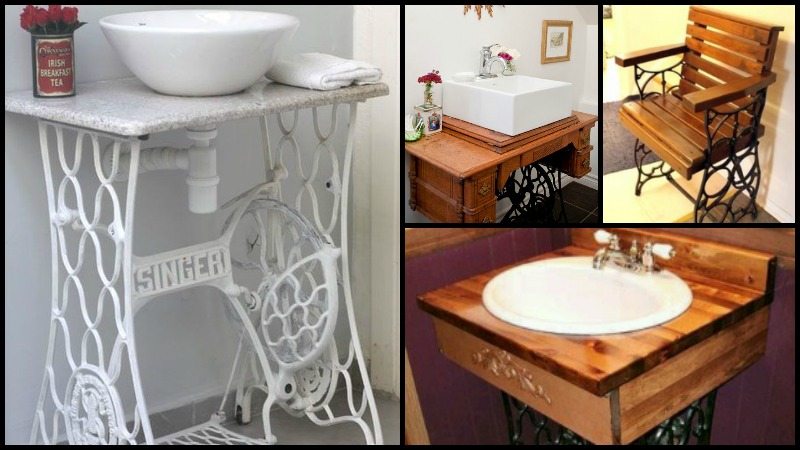
Do you have grandma’s old Singer sewing machine table in your storage? If you do, then you’ve got yourself a a chance for many upcycled sewing machine table projects.
These old model Singer sewing machine tables are no longer sold in the market these days, but they are considered of high value, much like heirloom pieces. Many people who are passionate about sewing still prefer to use these machines, as they believe that the quality of the stitches is superior to that of newer models.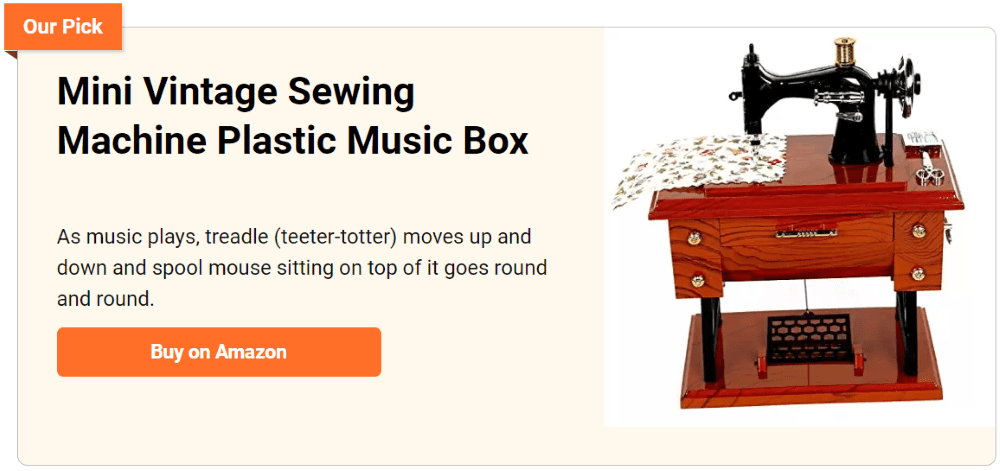
Some people even go so far as to say that these machines have a soul and that each one is unique. Whether you’re a sewing enthusiast or not, there’s no denying that these tables are beautiful pieces of history.
It’s not only because they are antique pieces, but more so because they make gorgeous and unique pieces of furniture. Upcycled sewing machine table projects can be functional and decorative at the same time. 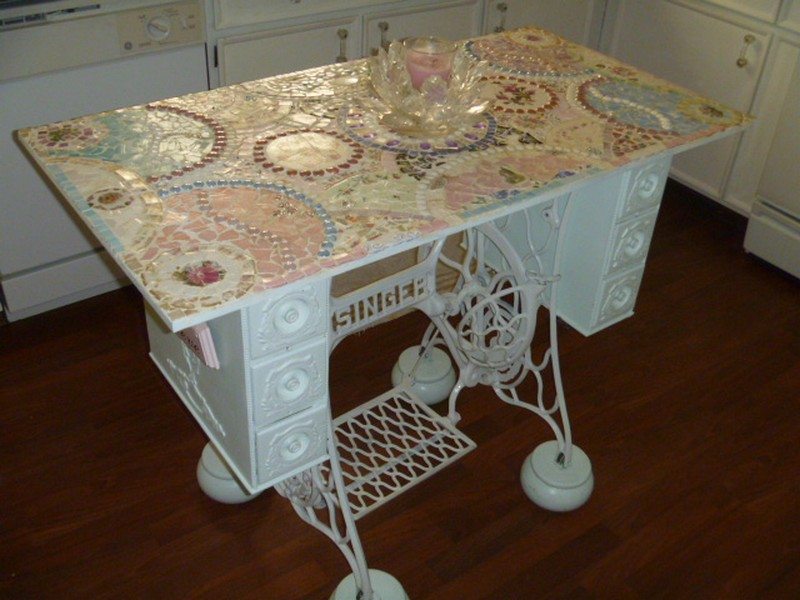
10 Creative Upcycled Sewing Machine Table Ideas
There are many ways you can make your old singer machine work for you. Below are 10 functional upcycled sewing machine table ideas to consider.
Bathroom Sink
Transforming an old Singer sewing machine table into a unique bathroom sink is a creative way to repurpose a vintage piece. This DIY project not only breathes new life into the table but also adds a touch of elegance and history to your bathroom.
To start, choose a basin that fits the style and dimensions of the sewing machine table. You may need to cut a hole in the tabletop to accommodate the sink, so precise measurements are crucial. Consider retaining the table’s original finish to preserve its vintage charm, or refinish it to match your bathroom decor. Install plumbing carefully to blend functionality with the table’s aesthetic.
This upcycled sewing machine table turned bathroom sink will surely be a conversation starter, offering both beauty and utility.
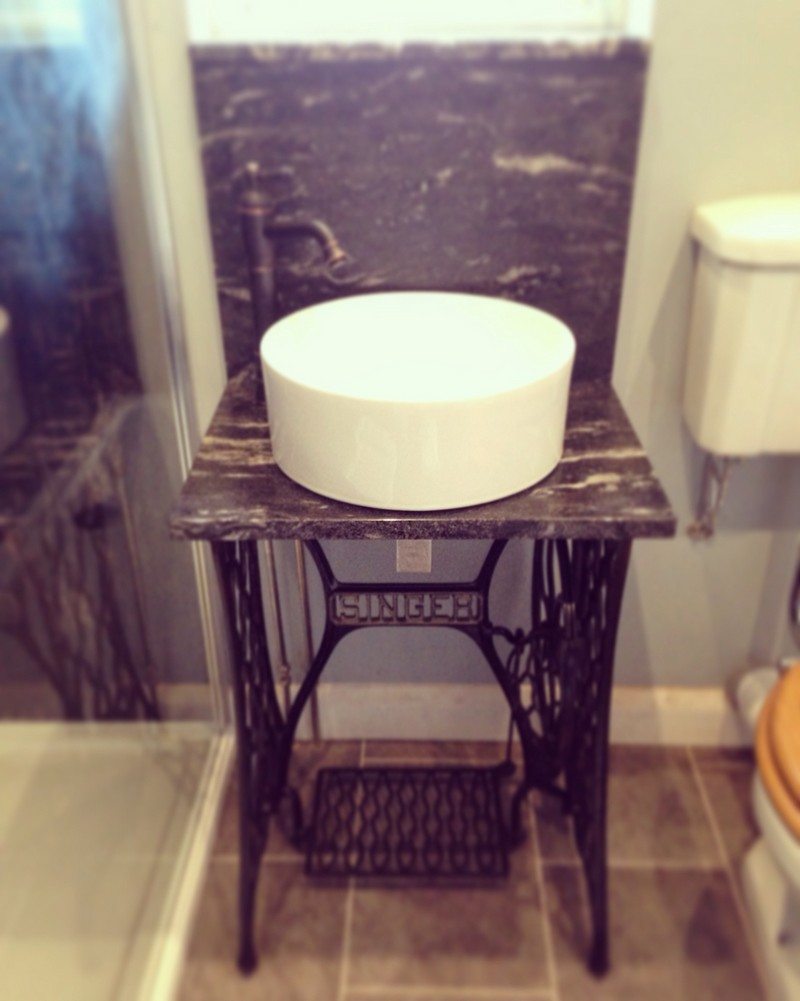

Makeup Table/Vanity
An upcycled Singer sewing machine table can effortlessly become a charming makeup table or vanity, providing a unique space for your beauty routine. Start by sanding the table to smooth out the surface, preparing it for a new coat of paint.
Shelves or small drawers can be added to hold cosmetics and accessories, enhancing the table’s functionality. Pair your newly upcycled sewing machine table vanity with a luxurious chair or stool to complete the look, creating a delightful spot for daily beauty rituals.
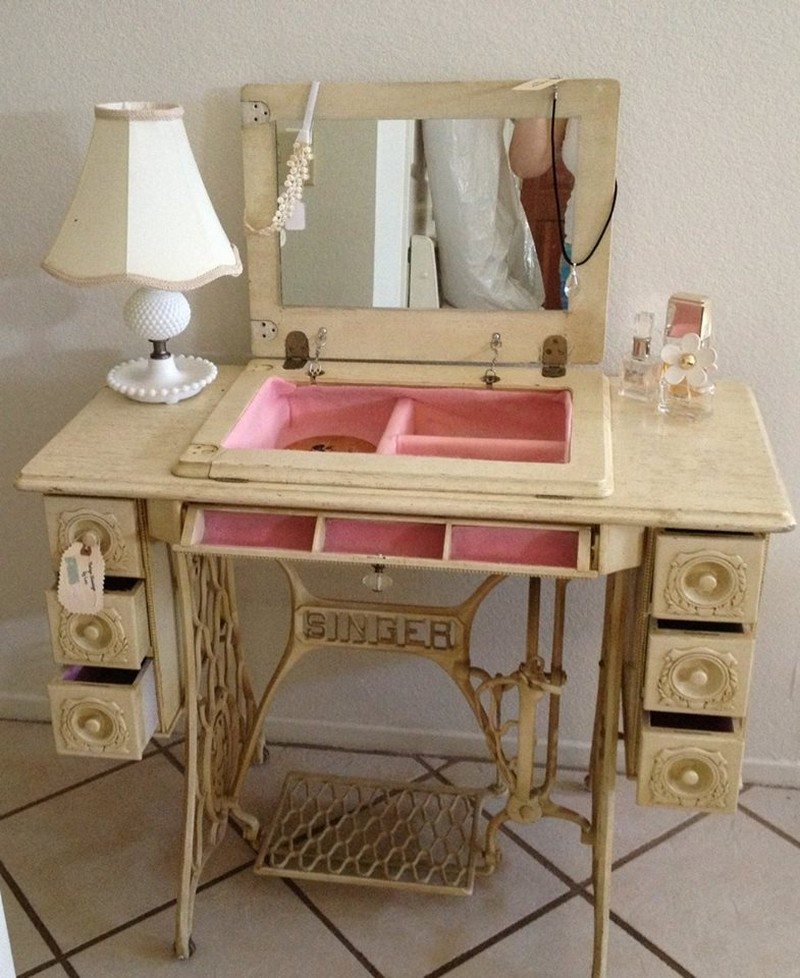
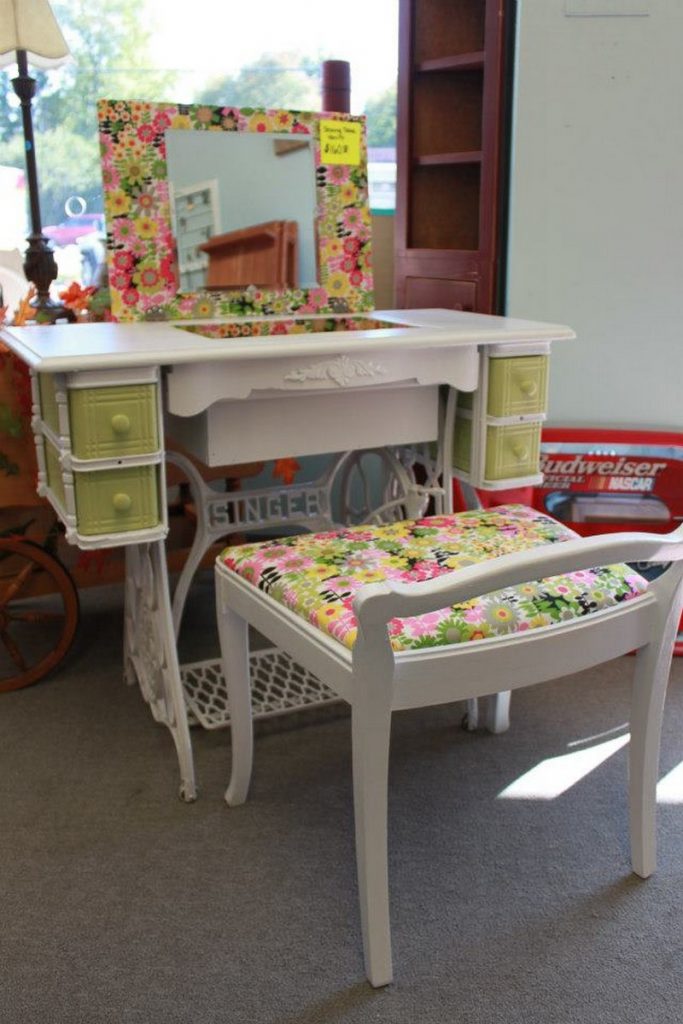
Sofa Table
An old Singer sewing machine table can be transformed into the perfect sofa table, offering both style and practicality. This upcycled sewing machine table adds a vintage flair to your living space, while serving as a convenient spot to display decor or hold drinks and snacks.
To adapt the sewing machine table for this new purpose, ensure it is the correct height and length to fit behind your sofa. You might want to refinish the table in a color that complements your living room’s palette or leave it in its original state to highlight its historical character. The unique features of the sewing machine table, such as the iron base and intricate details, make it an attractive and practical addition to your home.
This upcycled sewing machine table as a sofa table not only recycles a piece of history but also enhances your living space with its timeless charm.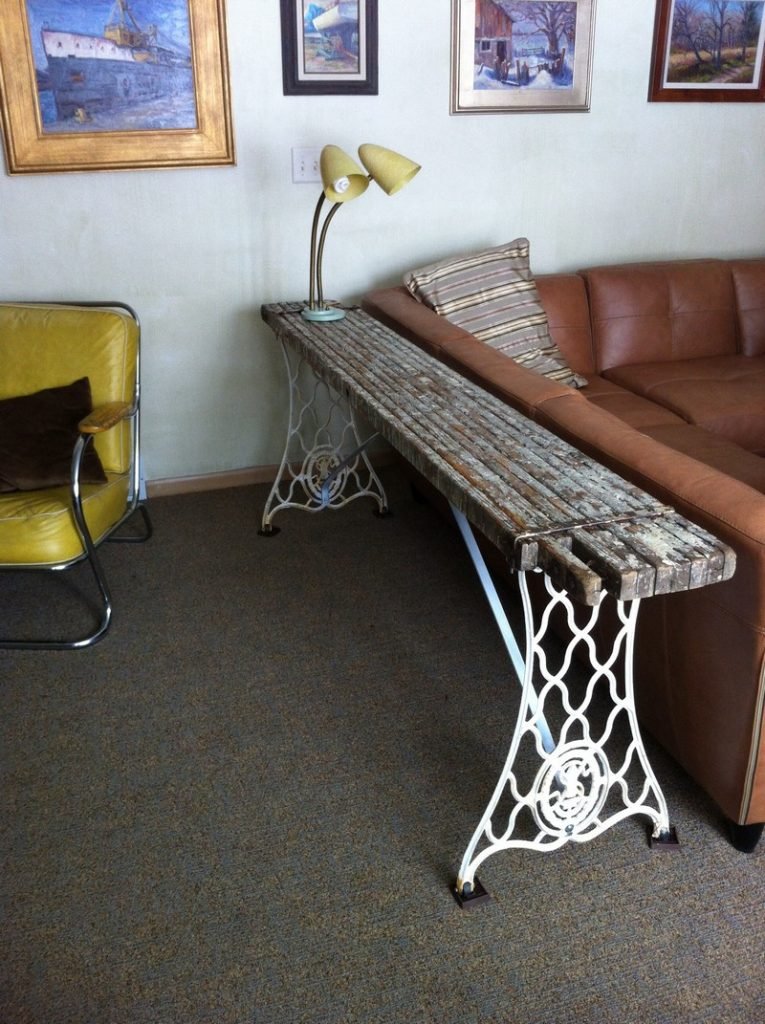
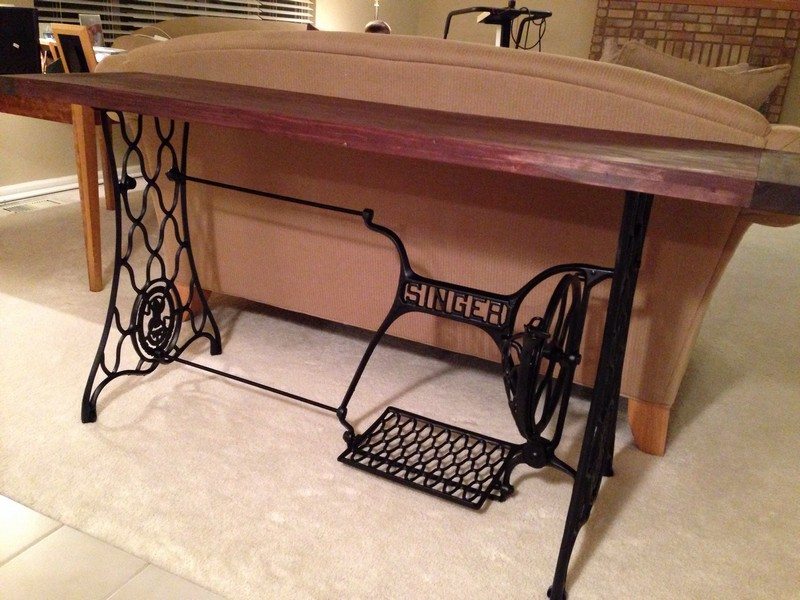
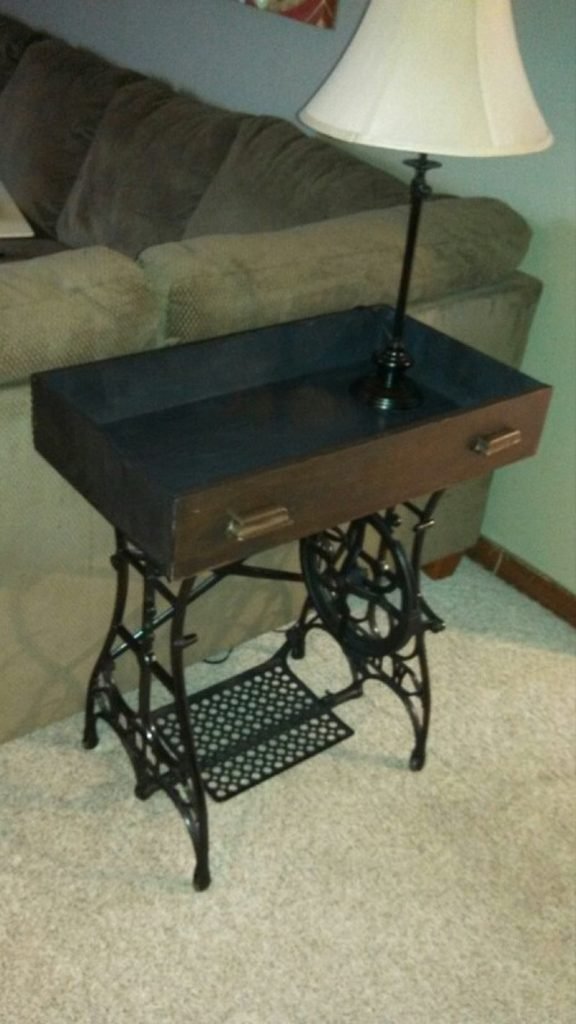
Table with Shelf
Turning an upcycled Singer sewing machine table into a makeup table or vanity is a fantastic way to add a touch of vintage elegance to your dressing area. Start by carefully sanding the table’s surface to create a smooth base for painting. Choose a paint color that reflects your style and enhances the room’s decor. A pastel shade can evoke a soft, romantic feel, while a bold hue might lend a more dramatic look to your space.
To complete your upcycled Singer sewing machine table vanity, select a chair or stool that complements the table’s vintage charm. Look for seating that is not only stylish but also comfortable, encouraging you to enjoy your beauty routine every day. This upcycled piece will not only serve a practical purpose but also act as a beautiful focal point in your room.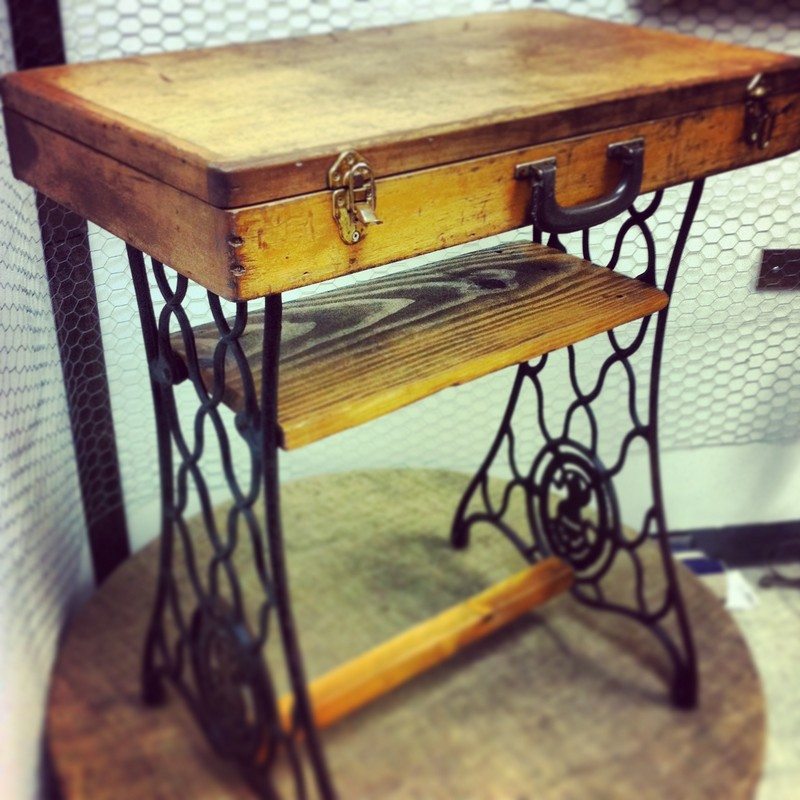

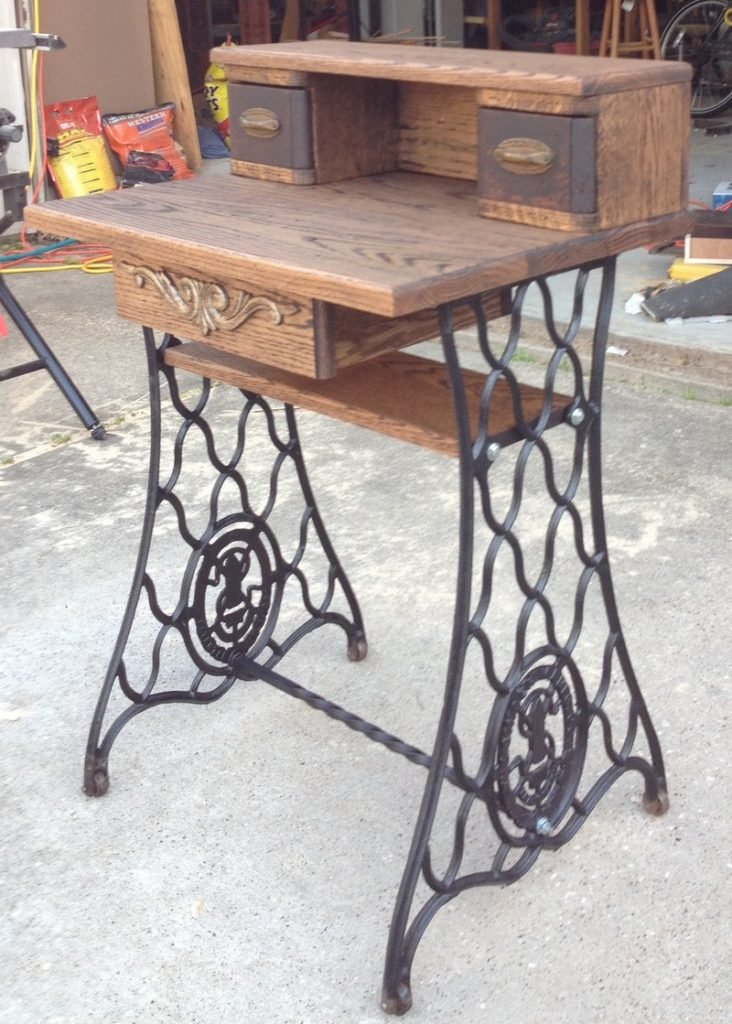
Planter
Transforming an old Singer sewing machine table into a planter is a unique way to repurpose this vintage item. Imagine filling the space where the sewing machine once sat with lush greenery or colorful flowers. This creative project gives the table new life and adds a stunning visual element to your garden or home interior.
To start, you may need to modify the table slightly, ensuring enough room to securely hold a planter box or pots. Sealing the wood can protect it from water damage, preserving the table’s beauty. This upcycled sewing machine table planter becomes a focal point, blending history with nature in a beautiful display.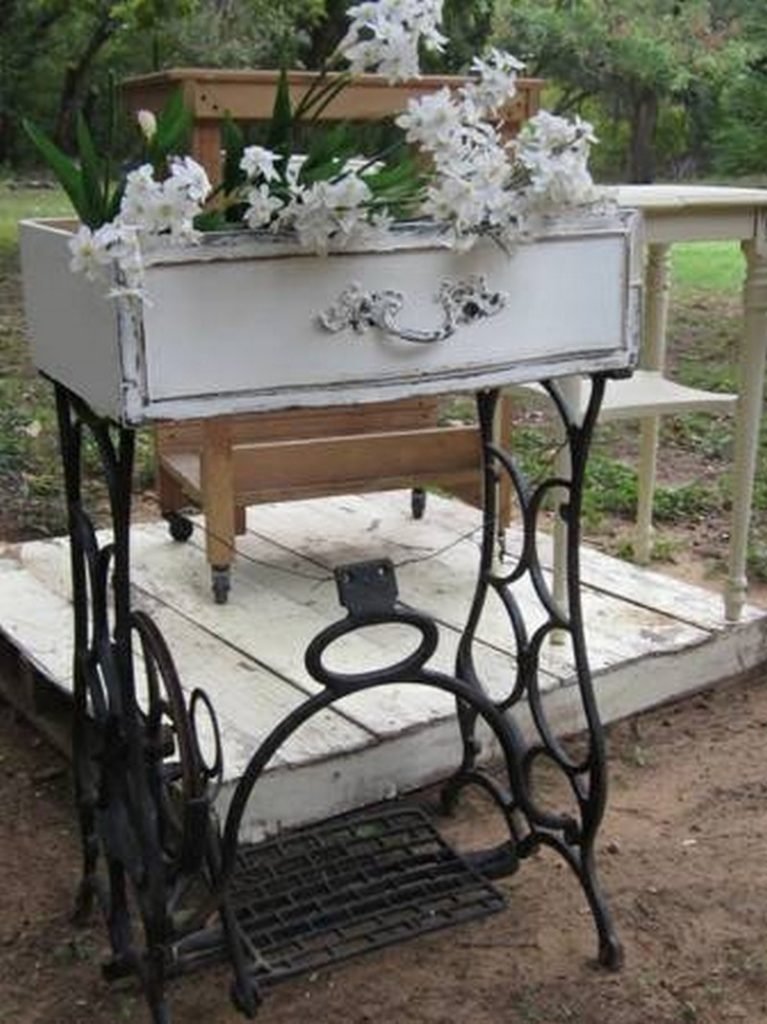
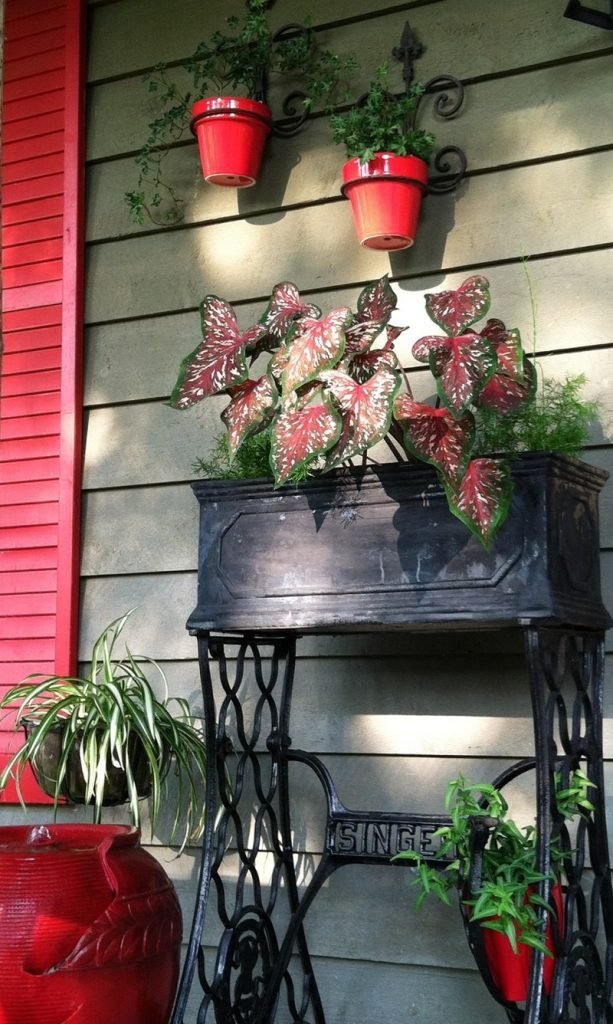
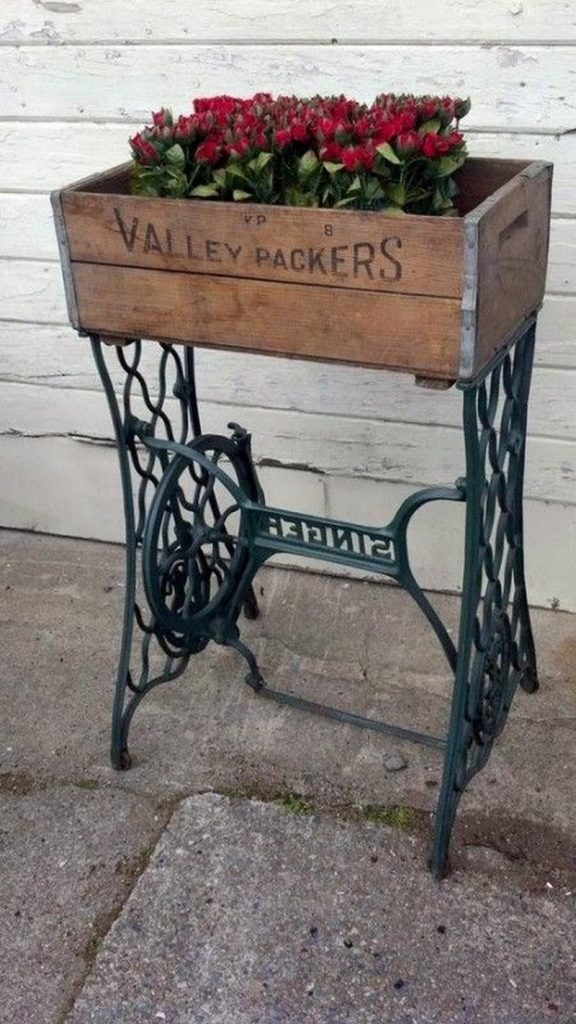
Kitchen Island/Butcher Block
An upcycled Singer sewing machine table can become an invaluable addition to your kitchen by transforming it into a kitchen island or butcher block. This approach adds extra counter space and incorporates a unique, vintage-inspired aesthetic into your kitchen.
To enhance functionality, consider attaching a butcher block top to the table, providing a durable surface for food preparation. Adding caster wheels to the bottom of the table can make it mobile, allowing you to move it wherever extra workspace is needed. This upcycled piece brings a touch of character and practicality to the kitchen, making it a standout feature.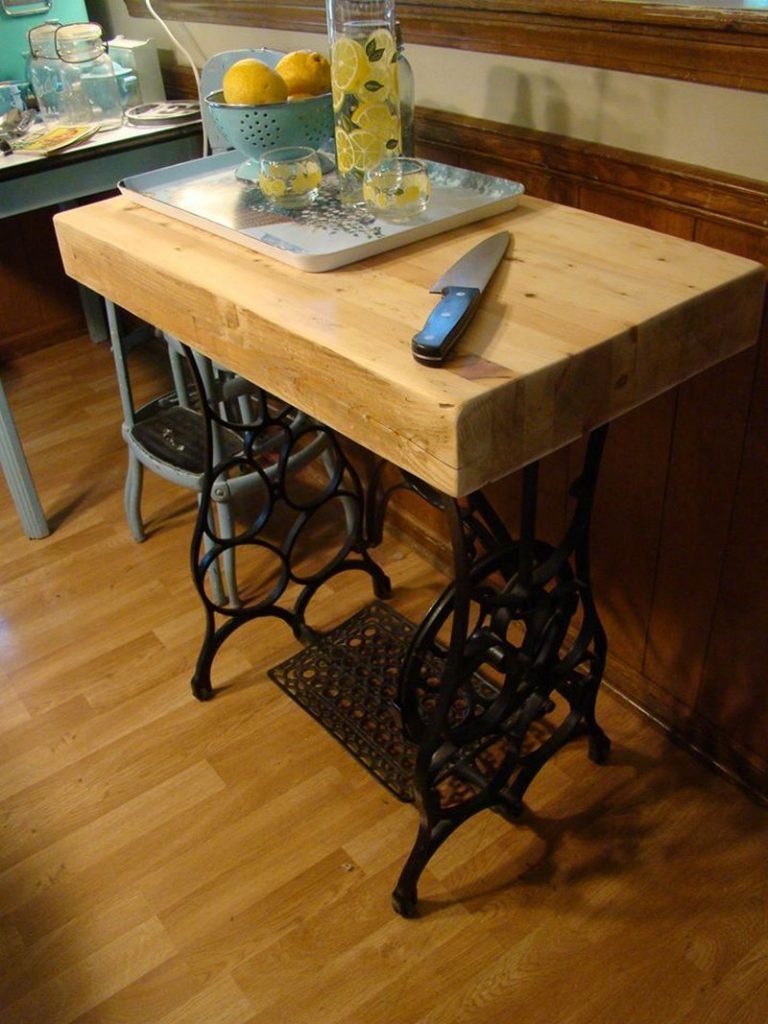

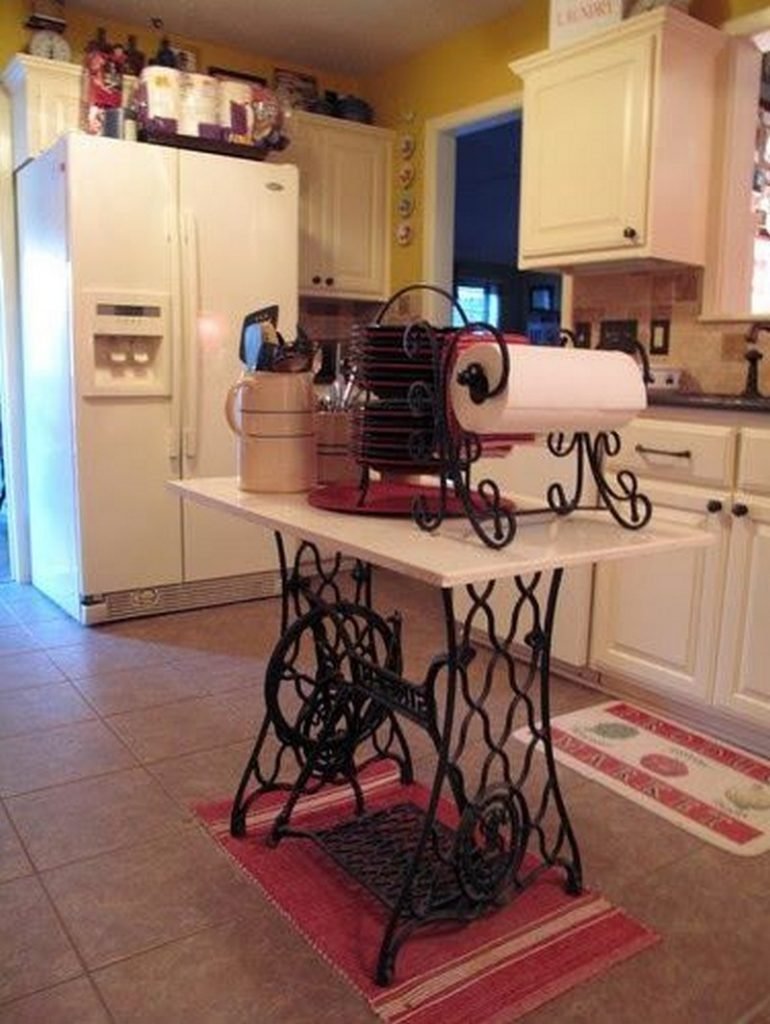
Entry Hall Table
An upcycled Singer sewing machine table can serve as the perfect entry hall table, offering a charming spot to organize keys, cellphones, and other small items. Its unique design and historical value add an elegant touch to your entryway, welcoming guests with its distinctive appeal.
The table can also be a convenient place to set down mail, bags, or decorative items, making your entryway both functional and stylish. Customizing the table with hooks for keys or a small bowl for loose items can further enhance its utility. This upcycled sewing machine table helps keep your entryway clutter-free and makes a statement with its vintage charm.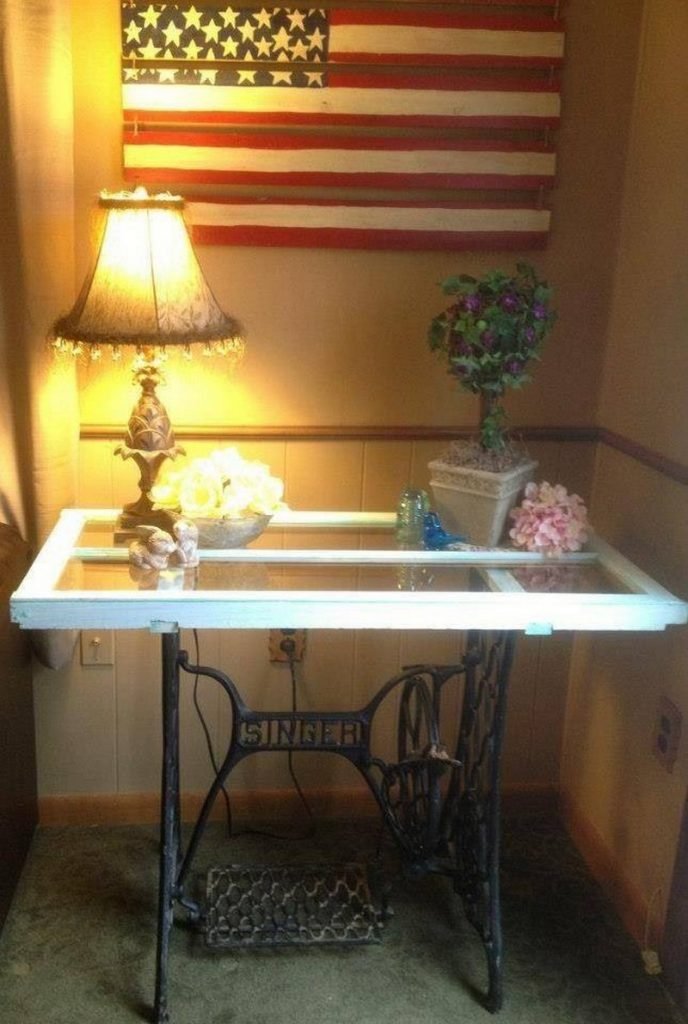
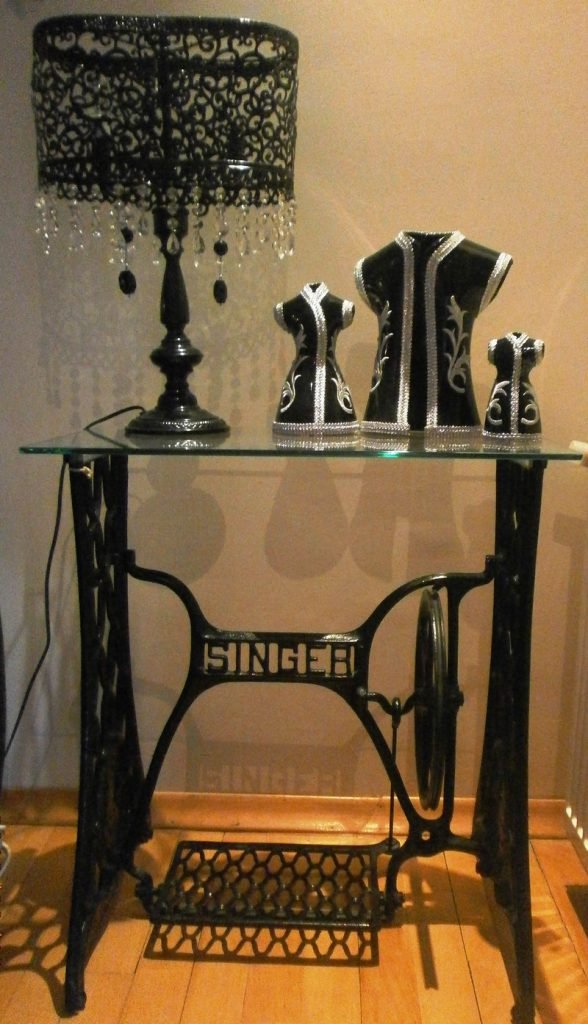
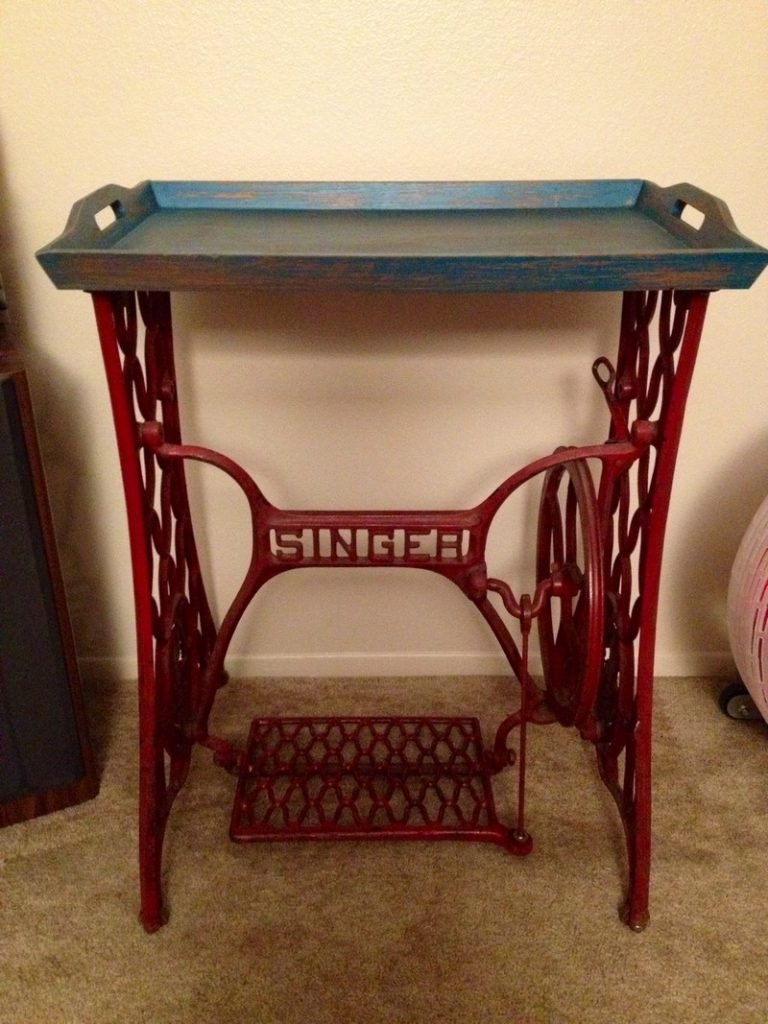
Chair
Converting an upcycled sewing machine table into a chair might seem unconventional, but repurposing this vintage piece is a brilliant way. To embark on this creative project, start by assessing the table’s structure to determine how it can be modified to function as a chair. This may involve removing the sewing machine and reinforcing the frame to support weight like a chair.
Cushioning can be added to the seat area for comfort, and fabric that complements the table’s original charm can cover it. This upcycled sewing machine table chair serves as a unique piece of furniture and sparks conversations about its innovative design and history.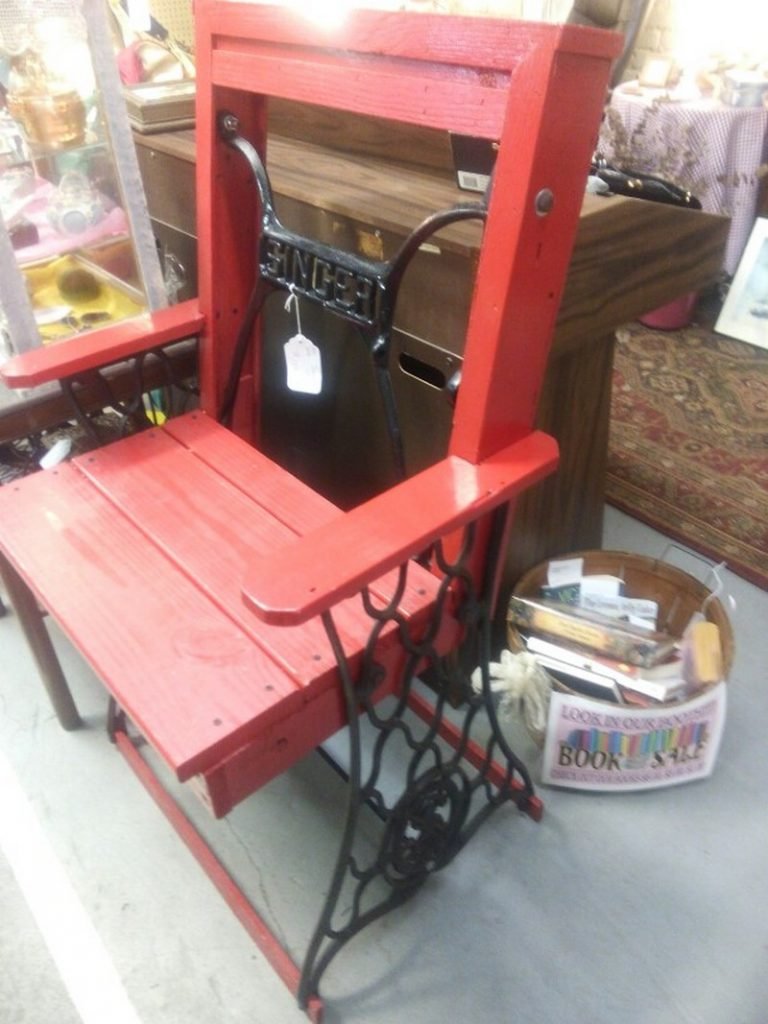
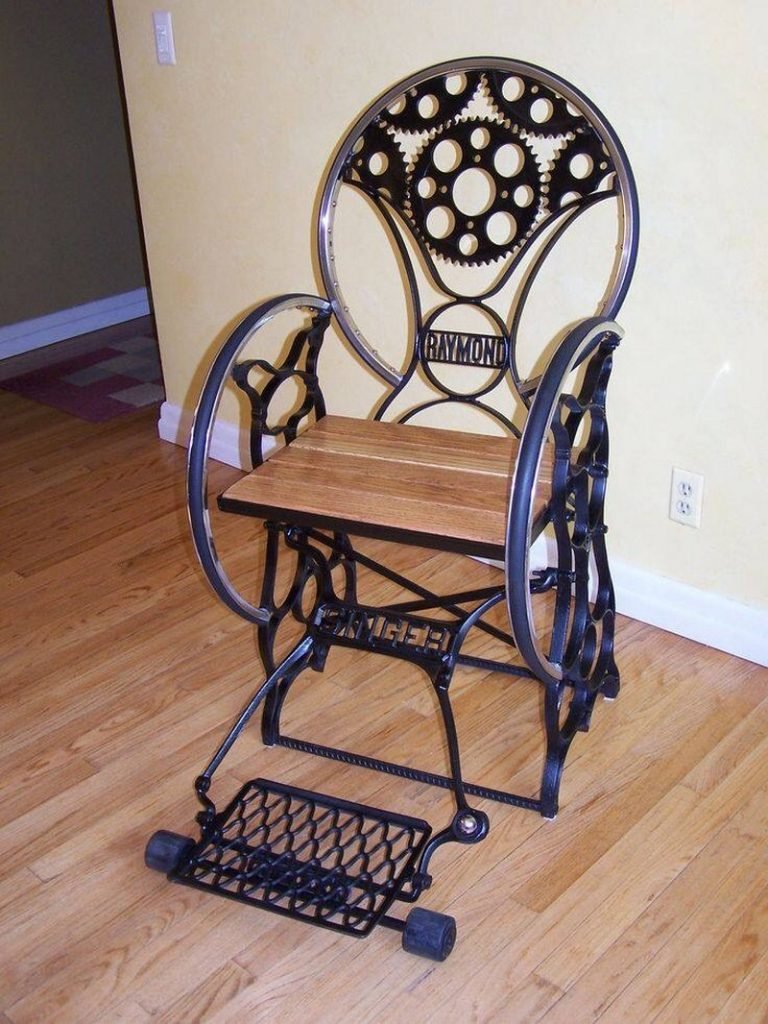
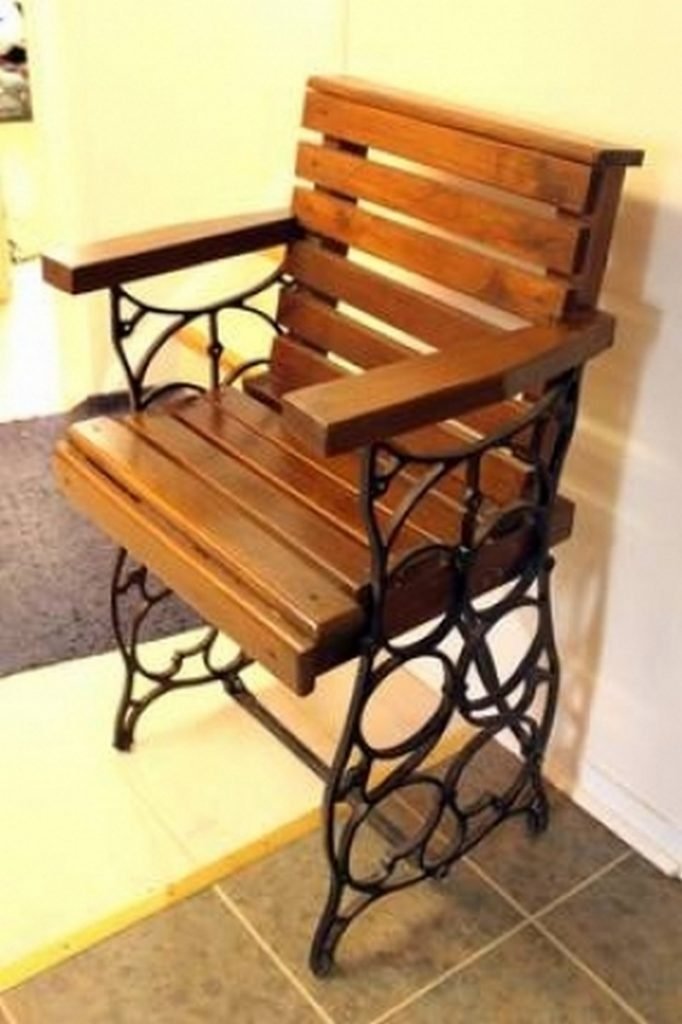
Coffee Bar/Wine Rack
Creating a coffee bar or wine rack from an upcycled sewing machine table offers a unique and stylish solution for your beverage storage needs. This project transforms the table into a functional piece that can store wine bottles, glasses, and coffee-making essentials. To begin, consider the layout and how you want to organize your items.
Adding shelves beneath the tabletop can provide space for wine bottles and coffee accessories. Hooks can hold cups and wine glasses underneath for easy access. Finishing the table in a style that matches your decor enhances its appeal as a focal point in your kitchen or dining area. This upcycled sewing machine table becomes a versatile station, perfect for entertaining or enjoying morning coffee.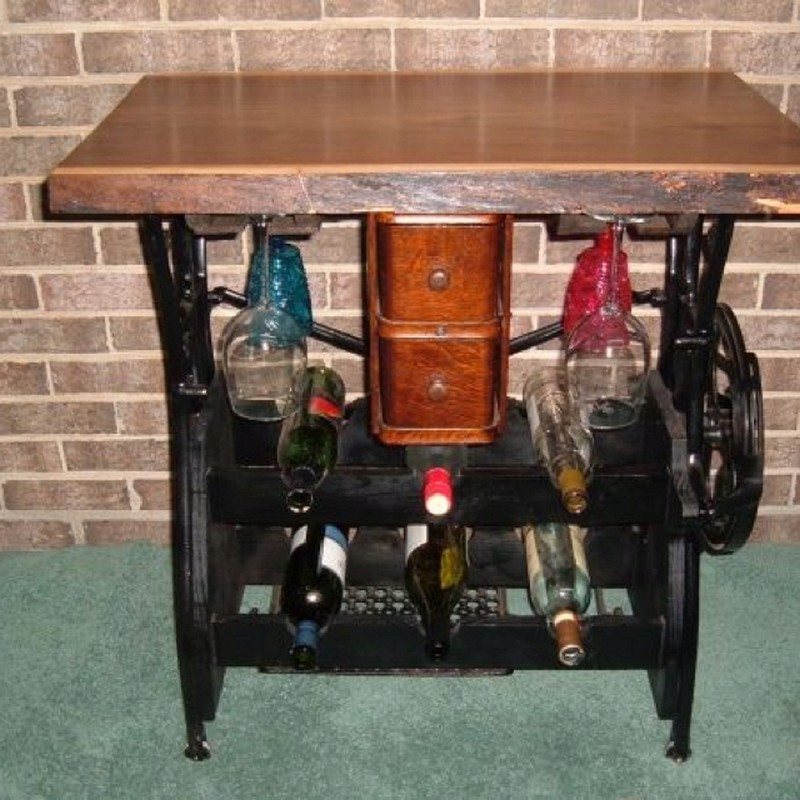
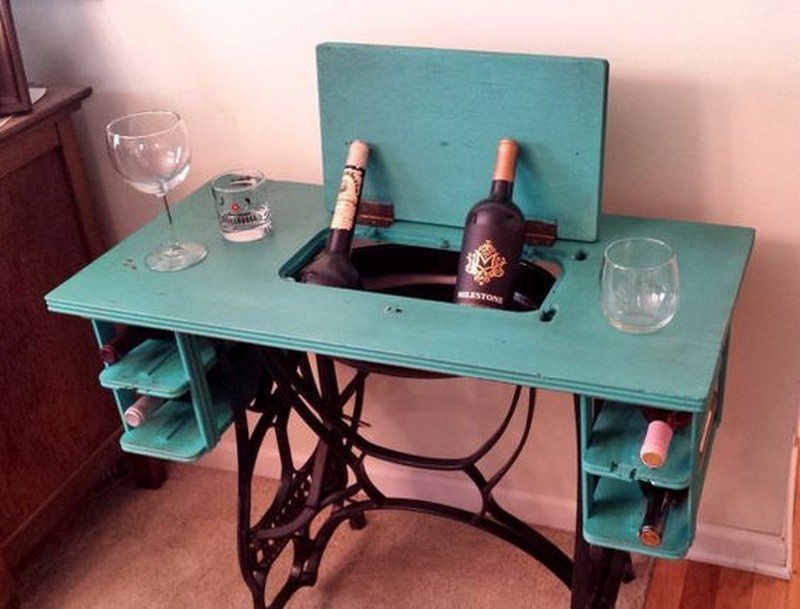
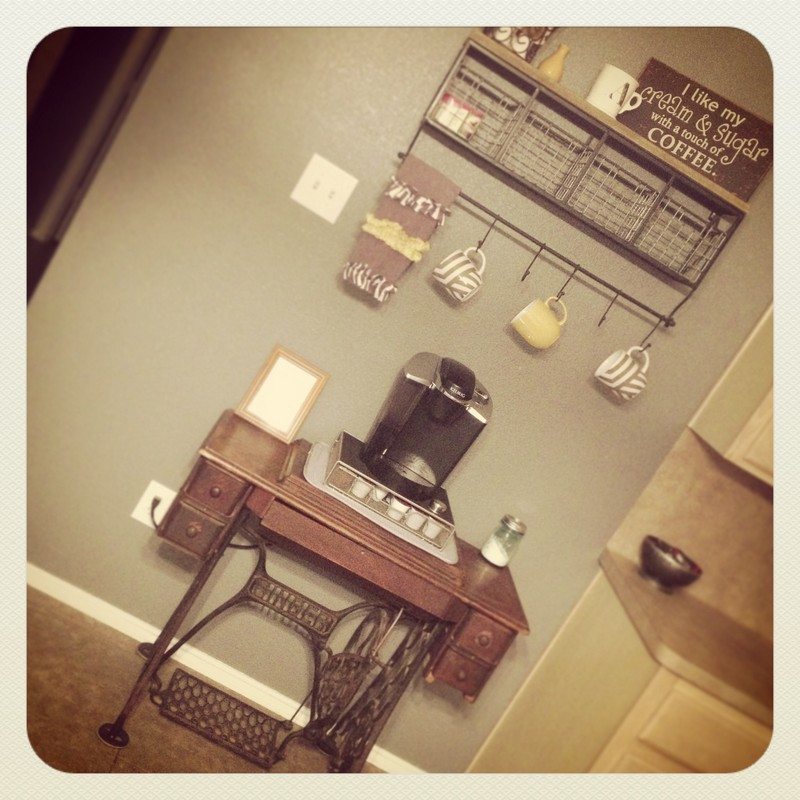
Farmhouse Dining Table
An upcycled sewing machine table can be beautifully transformed into a farmhouse dining table, adding a touch of rustic charm to any home. The sturdy construction of sewing machine tables makes them ideal candidates for this project. To convert the table into a dining surface, you may need to extend the tabletop to accommodate more people.
Using reclaimed wood for the extension maintains the rustic aesthetic and ensures the new piece blends seamlessly with the original table. Sanding and refinishing both the added wood and the existing table will unify the look, creating a cohesive and inviting dining area. This farmhouse dining table not only serves as a functional piece for family meals but also as a conversation starter, showcasing the creative repurposing of a vintage sewing machine table.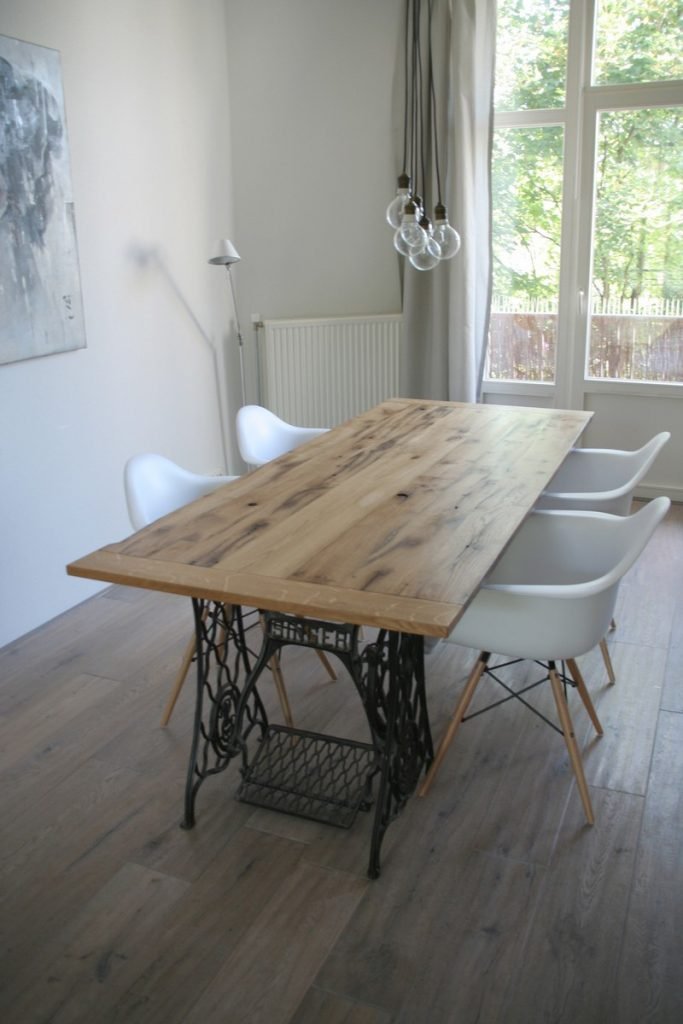
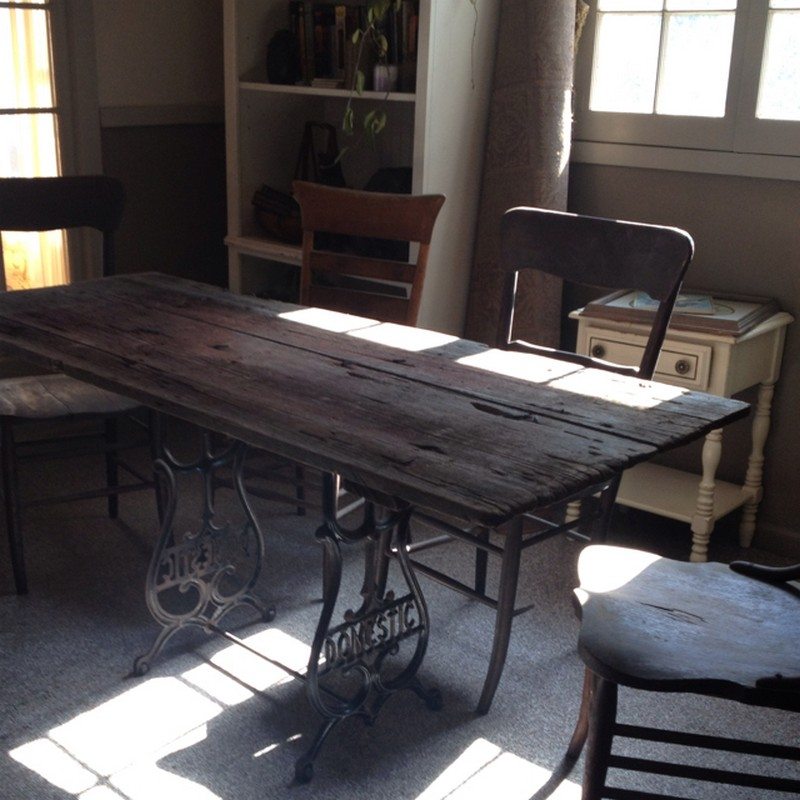
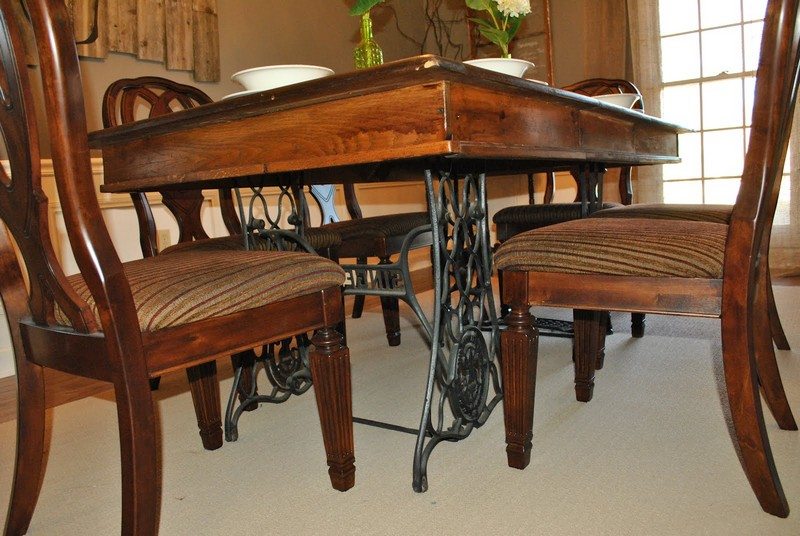
If you liked these, you will also like viewing these Recycling Ideas and Old sewing table turned colour popping planter.
Sewing Machine Table Restoration Tips
Restoring an old sewing machine table can transform it into stunning furniture. Whether it’s for use as a functional sewing table or an upcycled piece for your home decor, the process brings new life to these vintage treasures. Here’s how to restore an upcycled sewing machine table, making it beautiful and functional.
Assess the Condition
Assessing the condition of your upcycled sewing machine table is a critical first step in the restoration process. Begin with thoroughly examining the entire table, paying close attention to the wood and metal components. Look for any visible wear and tear affecting the table’s stability or aesthetic appeal.
Inspect the wood surfaces for scratches, dents, or areas where the varnish has worn off. These imperfections can often be addressed with sanding and refinishing, but it’s important to gauge the extent of the damage. Deep scratches or dents may require wood filler before sanding.
Metal parts are prone to rust and corrosion, especially on older tables. Examine all metal components, including the legs, sewing machine frame, and hardware. Light rust can be removed with sanding and polishing, but severe corrosion might necessitate replacement parts.
It’s not uncommon for vintage tables to have missing or broken parts. This could include drawers, knobs, or even parts of the sewing machine itself. Identifying these missing pieces early on will help you decide whether you need to source replacements or if you can modify the table without them.
Check the table’s overall stability. Wobbly legs or a loose sewing machine mount can compromise the table’s functionality. Tightening screws and reinforcing weak joints can often resolve these issues, ensuring the table is both safe and functional.
Cleaning and Prep
A thorough cleaning and prep work are essential before diving into the transformation of your upcycled sewing machine table. Start by wiping the entire table with a soft cloth to remove dust and debris.
For the wood surfaces, choose a gentle cleaner specifically designed for wood to ensure that you don’t strip away any existing finishes or patina contributing to its vintage charm. Apply the cleaner with a soft cloth, working in sections and wiping in the direction of the grain to avoid scratching the surface.
For the metal parts of the sewing machine table, such as the frame and hardware, a rust remover may be necessary if there’s noticeable corrosion. Apply the rust remover according to the product’s instructions, and use a soft brush or cloth to gently scrub away the rust. It’s important to protect the wood surfaces during this process to avoid any spillage that could damage the wood.
Once the table is clean, let it dry completely before moving on to any repairs. This prep stage is crucial for a successful upcycled sewing machine table restoration as it ensures that you’re working with a clean slate, allowing for better adhesion of paints or finishes you may apply later.
Repair and Replace
Ensuring the structural integrity of your upcycled sewing machine table is vital to its longevity and functionality. Begin by examining all joints, screws, and hardware.
Tighten any loose screws and bolts to secure the table’s structure. Wood glue can be an effective solution if you find any wood splits or cracks. Apply the glue into the crack and clamp the wood until it dries to ensure a strong bond.
In cases where parts of the table or sewing machine are broken or missing, you’ll need to decide whether to source replacements or adapt the table design to work without them. For unique or antique parts, consider contacting specialty restoration shops or online forums dedicated to sewing machine restoration for advice or sources for replacements.
For an upcycled sewing machine table, preserving its original features as much as possible is important to maintain its unique character. However, don’t shy away from replacing parts that are beyond repair if it means restoring the table’s functionality and safety. Each repair or replacement you make contributes to the table’s story and charm, ensuring it can be enjoyed for many years.
Sanding and Refinishing
Sanding and refinishing is crucial in restoring the beauty of your upcycled sewing machine table. Begin with a medium-grit sandpaper to remove the old varnish and surface imperfections.
Sanding should always be done toward the wood grain to prevent scratches that could detract from the table’s appearance. After the initial sanding, switch to fine-grit sandpaper for a smooth finish.
Once sanding is complete, remove all dust with a tack cloth to ensure a clean surface for refinishing. Choosing the right finish is important to enhance the table’s vintage appeal. You might opt for a stain that matches the original color or gives the wood a richer tone.
Alternatively, paint can offer a fresh, new look while still highlighting the table’s character. Apply the stain or paint with a brush or cloth, working in sections and following the manufacturer’s instructions for the best results. A final clear coat will add durability and protect the finish.
Polishing Metal Components
Polishing the metal components is essential to restoring the luster of your upcycled sewing machine table. Select a metal polish suited for the specific type of metal on your table, whether it be brass, steel, or iron.
Apply the polish with a soft cloth, rubbing in small circles to cover the entire surface. A small brush can help apply the polish effectively for intricate details or hard-to-reach areas.
After polishing, buff the metal with another clean, soft cloth to bring out the shine. This step restores the metal’s appearance and removes any oxidation that could lead to future rust. Polishing the metal components can significantly enhance the overall look of your upcycled sewing machine table, making it a standout piece in any room.
Protect and Preserve
The final step in the restoration process is to protect and preserve the newly refinished surfaces. For the wood, apply a sealant such as polyurethane, varnish, or wax.
This will protect the wood from scratches, water damage, and wear, ensuring the table remains beautiful for years to come. Apply the sealant according to the product instructions, using a brush or cloth, and allow it to dry completely.
For the metal parts, applying a protective wax can prevent rust and maintain the polished look. Choose a wax designed for metal surfaces and apply it sparingly with a soft cloth. This protective layer will shield the metal from moisture and oxidation, keeping it pristine.
Restoring an upcycled sewing machine table preserves a piece of history and gives you a unique furniture item for your home. With a little effort, you can enjoy the beauty and functionality of these vintage tables for years to come.
FAQ: Upcycling Sewing Machine Tables
- Why is it important to consider upcycled sewing machine tables, and how can they be educational for children?
- Preserving vintage sewing machines is a crucial endeavor for several compelling reasons. Firstly, these machines are built to last, often withstanding the test of time for over a century. Unlike many modern devices, vintage models are crafted with robust materials, resulting in unmatched durability and longevity. By maintaining these machines, we prevent valuable historical craftsmanship from fading into oblivion.
- What are some groups you can donate vintage sewing machine parts to for preservation and restoration?
- Many local and online clubs dedicate themselves to the restoration of antique sewing machines. These clubs often seek parts to maintain and repair century-old machines. They’re a great resource for ensuring your donation is put to good use. Historical society organizations may accept vintage sewing machine parts as part of their efforts to preserve historical artifacts. Donating to a historical society can help keep these machines in working order for educational exhibits and demonstrations.
- What are some alternative uses for an upcycled sewing machine table beside a kitchen island?
- Beyond transforming it into a kitchen island, a vintage sewing machine can also be repurposed into a distinctive desk, showcasing its versatility in home decor. Whether reimagined as a kitchen island or a desk, the timeless appeal and versatility of a vintage sewing machine table add elegance and functionality to any room.
- How can upcycled sewing machine tables be repurposed as garden tables or plant stands?
- To start, you may need to modify the table slightly, ensuring enough room to securely hold a planter box or pots. Sealing the wood can protect it from water damage, preserving the table’s beauty. This upcycled sewing machine table planter becomes a focal point, blending history with nature in a beautiful display.
- Why should you consider the heritage and artistry of vintage sewing machines before dismantling them?
- Beyond their aesthetic appeal, vintage sewing machines also hold immense practical and historical value. Many of these machines, with lifespans exceeding 100 years, continue to operate seamlessly. This speaks to the incredible craftsmanship and durability that define them.
Conclusion
Whether it’s turning them into a charming planter, a sophisticated makeup vanity, or a versatile kitchen island, each upcycled sewing machine table becomes a unique piece that enhances your home decor. This process not only showcases your personal style but also promotes environmental responsibility by giving a new life to old furniture.







